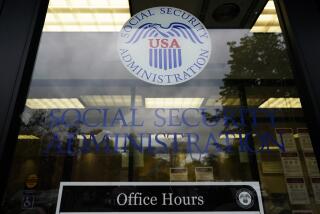Refinancing Surge Puts Cash in Pockets
- Share via
Since Pam Koegeboehn quit her job with a land developer in January to stay home with two children, the family has scraped by, “nitpicking over every cent,” as husband Doug Koegeboehn puts it.
But this week, the Koegeboehns completed a mortgage refinancing, trimming the monthly loan payments on their Aliso Viejo home by more than $200--and banking an extra $7,000 in cash, providing a financial cushion that will allow them to spend $500 or $600 on Christmas without losing sleep.
The holidays “will still be lean,” said Doug Koegeboehn, operations director for DGWB ad agency in Santa Ana. “But when the bank account doesn’t say zero, you don’t freak out every time you have to spend five bucks.”
In this most uncertain of holiday shopping seasons, many presents will arrive thanks to the low interest rates and record amounts of money extracted in refinancings.
The government-sponsored mortgage company Fannie Mae estimates $80 billion in home equity will be taken out in cash in 2001, with $50 billion spent rather than saved, reinvested or used to pay other debts.
David Berson, Fannie Mae’s chief economist, couldn’t say how much of the $50 billion will be spent in the fourth quarter. And if a big chunk of the cash goes toward home improvements and new cars, as it has in the past, that may not leave as much for Christmas shopping.
But the refinancing frenzy--and the amount of extra cash available for spending--are peaking as the holidays are approaching. Refinance volumes surged this month when average rates for 30-year fixed-rate mortgages tumbled below 6.5% two weeks ago, before spiking up to 6.75% this week.
Economists say so-called cash-out refinances could help offset the effects of layoffs, slumping corporate earnings and consumer confidence shaken by the terrorist attacks and subsequent events. Although personal-finance experts generally advise using such funds conservatively--to invest in a college education or consolidate higher-interest debt, a greater share of the refinancing dollars is expected to be spent this year than during the last refinance boom in 1998.
For the retail industry, the latest burst of refinancings couldn’t come at a better time.
The National Retail Federation is forecasting holiday sales will rise 2.5% over last year, as retailers discount heavily to attract shoppers and partly because of the windfall from refinancings. Last holiday season, the trade group said, $201 billion was spent on general merchandise, clothing, home furnishings, electronics, appliances, sporting goods and other products.
“The shock effect from Sept. 11 has worn off on a lot of consumers. They’re ready to shop,” said Scott Krugman, spokesman for the National Retail Federation. Besides refinancings, he also cited $38 billion in tax-rebate checks and reduced travel spending as additional factors that have put money in consumers’ pockets.
Not everyone is so optimistic that lower taxes and refinance cash-outs will stimulate retail sales. Richard Giss, a retail consultant with Deloitte & Touche in Los Angeles, said consumers cut back after Sept. 11 because splurging felt inappropriate and they saw the economy was badly damaged. And once spending changes so drastically, he said, it takes consumers longer than a month or two to revert to old habits.
What’s more, Giss said, retailers spooked by Sept. 11 and the general economic slowdown have held inventories so low that there aren’t enough goods available for much of a sales increase, even if a last-minute surge in demand takes place. That warning was echoed by other experts who advise shoppers to buy early if they want good selections.
Still, Giss’ firm thinks Christmas spending will be about the same as last year or possibly down 1.5%, with sales of luxury items such as jewelry taking the biggest lumps. But holiday sales may wind up higher than projections. After cutting spending, refinancing and postponing travel, consumers have plenty of money, Giss said. “The question is just when they’ll start spending it again.”
Refinancing Offers Cushion
Doug Koegeboehn, for example, said he would have tried to squeeze out the same amount of Christmas spending even without refinancing his home, which cost $210,000 four years ago and was appraised this month at $360,000. But without the cushion of the refinancing, he said, spending $500 to $600 for presents would have meant continued penny-pinching on every nonholiday item.
The Koegeboehns had a $200,000 first mortgage with a fixed rate of 7.25% and owed $60,000 on a home equity line of credit with a variable rate in the 9% to 10% range. Their new $270,000 loan has a 6% fixed rate that becomes adjustable after five years, when their children, now 2 and 5, will be old enough that Pam Koegeboehn can easily return to work.
Even with the extra breathing room provided by the refinance, the Koegeboehns are an example of how many consumers may be proceeding with caution.
The couple hope that much of the $7,000 in equity they pulled out and set aside can be used to pay down the principal on their new loan after their finances stabilize. “The main thing I think about is [financial] security,” he said. “I don’t want to live my whole life in debt.”
Consumer Cash-Outs Expected to Be Spent
During the previous refinancing boom in 1998, about half the $60 billion taken out by homeowners went to savings, investments or to repay debts, according to a Federal Reserve study. The other half was spent on home improvements and consumer purchases--an immediate $30-billion shot in the arm for the economy.
But a greater share of the home equity cashed out this year is expected to be spent--62% by Fannie Mae’s estimate. Why? For one thing, homeowners are far less likely to invest in stocks than in 1998, when the tech-driven bull market was in full stampede, Berson said.
Another factor is that homeowners in most parts of the country have enjoyed three years of solid home appreciation since then, increasing their wealth and giving them more room to spend.
The latest data suggest that the rate of home appreciation is now slowing. But that’s after national home prices rose 5.5% in 1998, 5.6% in 1999 and 8.4% in 2000, according to Fannie Mae data. The increases continued during the first half of this year, with home prices in the second quarter running 8.6% higher than the same quarter last year. The percentage increases have been even stronger in California.
Those huge gains, combined with low interest rates, have made home equity an enticing well to draw from. Although spending some of the cash will certainly help retailers and the overall economy, some experts worry about consumers loading up on more debt, which for many households is already at high levels.
Laura Tarbox, a Newport Beach certified financial planner, said home equity generally should be used to finance a car or college, pay off other consumer debts, invest or fix up the house. “But not for going to Nordstrom,” she said.
Using home equity for vacations or consumer purchases “is usually saying that the person needs more financial discipline,” said Karen Goodfriend, co-chair of the personal financial planning committee of the California Society of Certified Public Accountants. “They probably need to be saving more instead of taking money out.”
More to Read
Inside the business of entertainment
The Wide Shot brings you news, analysis and insights on everything from streaming wars to production — and what it all means for the future.
You may occasionally receive promotional content from the Los Angeles Times.











